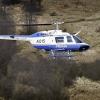Aer Lingus A320 near Dublin on Sep 7th 2012, flight attendant injured
An Aer Lingus Airbus A320-200, registration EI-CVA performing flight EI-437 from Milan Malpensa (Italy) to Dublin (Ireland) with 62 passengers and 6 crew, was descending through FL140 towards Dublin at about 21:38L (20:38Z) when the crew declared PAN medical emergency and reported one cabin crew member had fallen on board and received a bad fracture of her ankle. The aircraft continued for a safe landing on runway 28 about 12 minutes later, the flight attendant was taken to a hospital. After landing the crew reported the other three flight attendants needed medical attention as well.
The airline confirmed one flight attendant received injuries and was taken to a hospital.
Satellite images show no convective activity around Dublin area at the time of the occurrence.
On May 27th 2014 the Irish AAIU released their final report concluding the probable cause of the accident was:
An abrupt manual pitch input resulted in higher than usual g forces being experienced by the Cabin Crew Members.
Contributory Cause(s)
- The ATC Flight Level clearance was not immediately recorded when received.
- Unclear communication between the Flight Crew when confusion arose over the cleared flight level.
The AAIU reported that the aircraft had been enroute at FL380 when it was cleared to descend to FL340, the crew inadvertently selected FL240 into the altitude window however. During the descent the crew queried ATC about the cleared flight level, FL340 was confirmed. Just before descending through FL340 the crew thus disconnected the autopilot and a manual control input was made to level the aircraft at FL340. As result a cabin crew member at the aft galley sustained a broken ankle due to the sudden pitch change and related vertical acceleration.
The AAIU reported that the first officer (52, ATPL, 10,300 hours total, 2,550 hours on type), pilot monitoring, had correctly read back FL340 as cleared flight level, the captain, pilot flying, queried whether they were cleared at FL240 or below at waypoint LIPGO. The captain (40, ATPL, 7,200 hours total, 3,137 hours on type) subsequently amended the MCDU with the restriction. The first officer believed he wrote down FL240 as cleared flight level into the flight log because of the captain's query and later amended to show FL340. When the aircraft descended through FL360, he wanted to make the call "2000 feet to level off" but noticed the altitude window had been set to FL240, the radio frequency was busy until the aircraft descended through FL352, then ATC confirmed FL340 as their cleared level, the aircraft was descending through FL345 at that point. The captain disconnected the autopilot and manually levelled off. Soon after a cabin crew member contacted the cockpit that one of the flight attendants had broken her ankle, which was met with disbelief, soon after all cabin crew members reported feeling unwell and a medical PAN was declared.
The AAIB reported the senior cabin crew member was in the forward cabin with a catering cart when she felt enormeous pressure combined with ringing ears, numb lips and seeing black spots. Subsequently she observed all other flight attendants were on the floor in different positions of the cabin. Flight attendant #3 was clearly injured with a broken ankle she called the cockpit and was met with disbelief. An announcement for a doctor was made, a passenger identified himself as doctor and provided first aid to the injured flight attendant. An able bodied passenger was briefed to assit with opening the aircraft doors in case the aircraft needed to be evacuated after landing.
The injured flight attendant reported that she felt being lifted off her feet and then thrown down onto the floor. She felt her ankle was injured and asked for help, a doctor provided first aid and applied splints. The hospital determined her ankle was fractured.
The flight data recorder showed the pitch angle changed from -2.5 to +0.4 degrees changing the vertical acceleration from +1G to +1.7G and +0.8G within 3.4 seconds. Then the vertical acceleration oscillated a little before settling at +1G again.
The AAIU analysed that the cockpit voice recorder revealed a good cooperation between the crew with a professional but relaxed atmosphere. The descent clearance had been read correctly back by the first officer, the captain however had understood FL240 and set the altitude window accordingly. The subsequent cross check by the first officer failed to detect the incorrect flight level set at the FCU stating: "As the PM had recorded on the flight log what the PF had incorrectly set and announced, as opposed to what he himself had correctly read back to ATC, the crosscheck was ineffective and the error was not trapped at that time."
The AAIU analysed with respect to the captain levelling off in a hurry: "His attempts to capture the altitude by re-selecting the flight level on the FCU were not successful and, although pushing the V/S-FPA knob would have levelled the aircraft automatically, the PF reacted by disconnecting the autopilot and quickly levelled off using a manual, side stick pitch input. It is possible that the reason the PF did not push the V/S-FPA knob is that this action is rarely done in normal operation whereas reselecting a flight level is a routine activity."
With respect to aircraft handling the AAIU analysed: "Although descending, the aircraft was still at an altitude where careful consideration should have been given to the aerodynamic handling aspects of high altitude operations. Although the Airbus A320 fly-by-wire system incorporates flight envelope protection, and the aircraft was operating well within its usual g limits, industry recommendations are that consideration should always be given to aircraft energy management and the careful manipulation of flight controls. Large and/or abrupt manual flight control inputs should be avoided, particularly at high altitudes where the potential for aircraft upset and activation of flight envelope protection exists."
Metars:
EIDW 072230Z 24006KT 9999 -DZ FEW010 SCT016 BKN025 17/16 Q1023 NOSIG
EIDW 072200Z 24005KT 9999 FEW010 SCT016 BKN025 17/16 Q1023 NOSIG
EIDW 072130Z 29005KT 9999 FEW010 SCT016 BKN027 18/16 Q1023 NOSIG
EIDW 072100Z 26007KT 9999 FEW017 BKN030 18/16 Q1023 NOSIG
EIDW 072030Z 27006KT 9999 FEW017 BKN030 18/16 Q1023 NOSIG
EIDW 072000Z 23006KT 9999 FEW017 BKN030 18/16 Q1023 NOSIG
EIDW 071930Z 23004KT 9999 FEW017 BKN033 18/16 Q1023 NOSIG
EIDW 071900Z 24006KT 9999 FEW017 BKN033 18/16 Q1023 NOSIG
EIDW 071830Z 25006KT 9999 FEW017 BKN030 19/16 Q1023 NOSIG
EIDW 071800Z 24009KT 9999 FEW017 BKN030 19/16 Q1023 NOSIG
http://avherald.com/h?article=455911f9














Komentarze